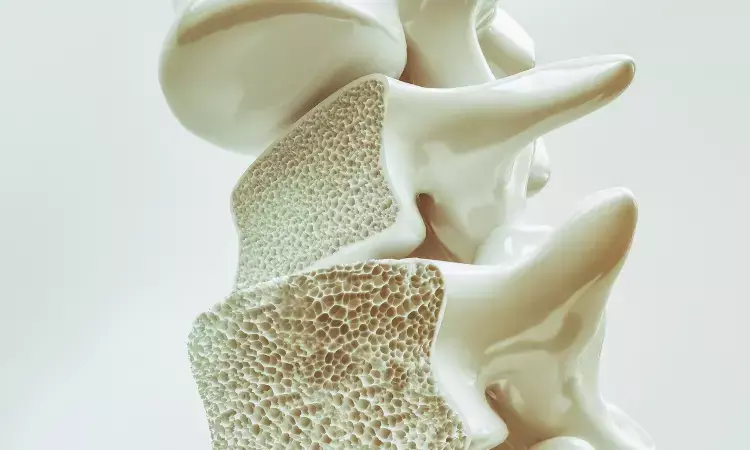- Home
- Medical news & Guidelines
- Anesthesiology
- Cardiology and CTVS
- Critical Care
- Dentistry
- Dermatology
- Diabetes and Endocrinology
- ENT
- Gastroenterology
- Medicine
- Nephrology
- Neurology
- Obstretics-Gynaecology
- Oncology
- Ophthalmology
- Orthopaedics
- Pediatrics-Neonatology
- Psychiatry
- Pulmonology
- Radiology
- Surgery
- Urology
- Laboratory Medicine
- Diet
- Nursing
- Paramedical
- Physiotherapy
- Health news
- Fact Check
- Bone Health Fact Check
- Brain Health Fact Check
- Cancer Related Fact Check
- Child Care Fact Check
- Dental and oral health fact check
- Diabetes and metabolic health fact check
- Diet and Nutrition Fact Check
- Eye and ENT Care Fact Check
- Fitness fact check
- Gut health fact check
- Heart health fact check
- Kidney health fact check
- Medical education fact check
- Men's health fact check
- Respiratory fact check
- Skin and hair care fact check
- Vaccine and Immunization fact check
- Women's health fact check
- AYUSH
- State News
- Andaman and Nicobar Islands
- Andhra Pradesh
- Arunachal Pradesh
- Assam
- Bihar
- Chandigarh
- Chattisgarh
- Dadra and Nagar Haveli
- Daman and Diu
- Delhi
- Goa
- Gujarat
- Haryana
- Himachal Pradesh
- Jammu & Kashmir
- Jharkhand
- Karnataka
- Kerala
- Ladakh
- Lakshadweep
- Madhya Pradesh
- Maharashtra
- Manipur
- Meghalaya
- Mizoram
- Nagaland
- Odisha
- Puducherry
- Punjab
- Rajasthan
- Sikkim
- Tamil Nadu
- Telangana
- Tripura
- Uttar Pradesh
- Uttrakhand
- West Bengal
- Medical Education
- Industry
Low BMI and calcium observed in women with lactation-associated osteoporosis: Frontiers

A new study published in the journal of Frontiers of Endocrinology revealed that low calcium intake, age at pregnancy, prior fragility fractures, the presence of chronic diseases prior to pregnancy, inadequate weight gain, low-molecular-weight heparin (LMWH) use, and low calcium intake during pregnancy are all linked to pregnancy and lactation-associated osteoporosis (PLAO), a condition that has a significant impact on women's health.
Bone fragility is a hallmark of PLAO that frequently manifests as vertebral or other fragility fractures in late pregnancy or the postpartum period. Maternal health, quality of life, and functional independence are all significantly impacted by this disorder. Little is known about the risk factors for PLAO. Thus, this study was set to determine the risk factors for PLAO, both pregnancy-related and unrelated.
For this study, 182 women without PLAO and 155 women with PLAO were given a questionnaire about their pregnancy-related characteristics, lifestyle factors, nutritional practices, and clinical history.
In comparison to women without PLAO (31.6 ± 5.4 years, 13.8%, 5.5%, 2.2%, 2.6%, 50.8%, 6.0%, 0.5%, 11.0%, p<0.05 for all comparisons), women with PLAO were older (32.9 ± 4.7 years), had a higher prevalence of BMI <18.5 Kg/m2 (23.6%), eating disorders (11.6%), amenorrhea (7.1%), chronic diseases associated with bone fragility (11.7%), calcium intake <500 mg/day (66.9%), blue sclerae (5.2%), and had a family history of vertebral/femoral FXs (21.0%).
Pregnancy fragility fractures (odds ratio, OR 2.7, 95% Confidence Interval, CI, 1.199-6.036, p=0.016), chronic diseases (OR 5.8 95% CI, 1.919-17.562, p=0.002), age at pregnancy (OR 1.1, 95% CI, 1.005-1.109, p=0.030), BMI<18.5 Kg/m2 (OR 2.0, 95% CI, 1.042-3.902, p=0.037), and calcium intake <500 mg/day (OR 2.5 95% CI, 1.485-4.166, p=0.01) were all linked to the risk of PLAO.
PLAO women were more likely to have a history of bed rest (21.9%), usage of low-molecular-weight heparin (LMWH, 25.2%), calcium consumption <500 mg/day (67.1%), and inadequate weight growth (49.0%) during pregnancy.
LMWH usage (OR 2.0, 95% CI, 1.124-3.682, p=0.019), inadequate weight growth (OR 1.8, 95% CI, 1.109-3.003 p=0.018), and calcium consumption <500 mg/day during pregnancy (OR 1.5, 95% CI, 1.047-2.141, p=0.027) were linked to an elevated risk of PLAO. Overall, the characteristics that may be evaluated prior to pregnancy and linked to PLAO include underweight, inadequate calcium consumption, age at pregnancy initiation, prior fragility fractures, and the presence of chronic conditions.
Source:
Grassi, G., Zampogna, M., Atlasova, A., Rondinella, S., Ghielmetti, A., Siracusano, G., Chiodini, I., Mantovani, G., & Eller-Vainicher, C. (2025). Identifying risk factors for pregnancy and lactation-associated osteoporosis: insights from an Italian survey in PLAO patients and controls. Frontiers in Endocrinology, 16(1612188). https://doi.org/10.3389/fendo.2025.1612188
Neuroscience Masters graduate
Jacinthlyn Sylvia, a Neuroscience Master's graduate from Chennai has worked extensively in deciphering the neurobiology of cognition and motor control in aging. She also has spread-out exposure to Neurosurgery from her Bachelor’s. She is currently involved in active Neuro-Oncology research. She is an upcoming neuroscientist with a fiery passion for writing. Her news cover at Medical Dialogues feature recent discoveries and updates from the healthcare and biomedical research fields. She can be reached at editorial@medicaldialogues.in
Dr Kamal Kant Kohli-MBBS, DTCD- a chest specialist with more than 30 years of practice and a flair for writing clinical articles, Dr Kamal Kant Kohli joined Medical Dialogues as a Chief Editor of Medical News. Besides writing articles, as an editor, he proofreads and verifies all the medical content published on Medical Dialogues including those coming from journals, studies,medical conferences,guidelines etc. Email: drkohli@medicaldialogues.in. Contact no. 011-43720751


